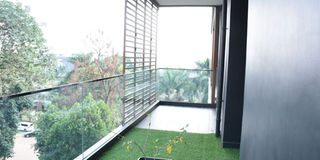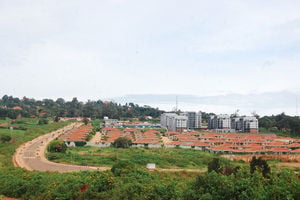
The boundaries between inside and outside blur, inviting residents to embrace nature as an integral part of their living environment.
PHOTO/unsplash.com.
As urbanisation accelerates and lifestyles evolve, the question arises: Is Uganda ready for contemporary housing? Uganda is experiencing a rapid urban transformation, with cities expanding and populations growing. As more Ugandans migrate to urban centres searching for economic opportunities, the demand for modern housing options escalates. However, the existing housing often falls short of meeting contemporary standards, leaving many urban dwellers grappling with inadequate infrastructure and substandard living conditions.
Despite the challenges, Uganda presents a fertile ground for contemporary housing development. With a burgeoning middle class and increasing disposable income, there is a growing appetite for modern amenities and lifestyle conveniences. Recognising this demand, developers have seized the opportunity to introduce innovative housing concepts that satisfy the progressive style of urban residents.
Why contemporary?
Contemporary design has endeared itself with homeowners because of its f tranquility. Gone are the cluttered spaces and ornate embellishments of the past. In its place, are clean lines and minimalist decor, where every element serves a purpose.
Moses Lutalo, the Managing Director Broll Uganda Limited, says contemporary housing reflects the preferences and needs of today’s society, incorporating elements such as sustainability, technology, and customsation. Lutalo says one of the defining features of contemporary design is its emphasis on open floor plans and ample natural light.
Large windows and strategically placed skylights bathe the interiors in sunlight, creating a sense of warmth and connection to the outdoors. The boundaries between inside and outside blur, inviting residents to embrace nature as an integral part of their living environment. As such, this has become the go-to design for homeowners with access to stunning views such as water bodies, mountain ranges, or the city skyline.
“If you move through most of Uganda’s affluent suburbs, you will notice that most new structures are constructed with a focus on modern living and feature luxury amenities; this is contemporary design. These areas often attract homeowners seeking sleek, upscale residences with clean lines, open floor plans, and high-end finishes,” Lutalo observes.
Demographic shifts, including changing household sizes, generational preferences, and cultural diversity, are driving demand for housing that reflects diverse lifestyles and values. Contemporary housing offers a wide range of options to accommodate varying needs and preferences, from compact urban apartments to luxury suburban homes.
Materials
Contemporary design often incorporates modern and sometimes high-end materials such as glass, steel, concrete, and natural stone. While these materials can create stunning visual effects, they may come with higher price tags compared to traditional materials such as wood or brick.
Contemporary architecture often allows for a high degree of customisation and personalisation to suit individual preferences and lifestyle needs. It may feature unique shapes, angles, and structural elements that require specialised design expertise and construction techniques. All this complexity comes at a high cost as intricate details and unconventional building methods may require additional time and labor.
“However, all this investment pays off because there is ready demand for contemporary homes. These homes attract top-tier tenants willing to pay from $5,000 (about Shs19m) a month and above. And in case one decides to sell off their property, they are bound to make a decent profit as contemporary homes often command higher resale values compared to traditional properties,” Lutalo notes.
Décor for a contemporary home
Diana Nakubulwa an interior designer based in Bweyogerere says choosing décor for a contemporary home involves selecting furnishings, accessories, and finishes that complement the clean lines, minimalist aesthetic, and modern sensibility of the space. She suggests furniture with clean lines, geometric shapes, and minimal embellishments. “Look for pieces made from materials such as metal, glass, or leather that offer a sleek and modern appearance. Modular furniture is also a great choice for its versatility and space-saving features,” she says.
Nakubulwa recommends a neutral colour palette theme such as shades of white, gray, black, and taupe as the foundation for your décor. “These colours create a sense of calm and sophistication that is characteristic of contemporary design. You can add pops of colour through accent pillows, artwork, or accessories for visual interest,” she suggests.
For lighting, the interior designer recommends fixtures with clean lines and modern finishes that complement the overall aesthetic of the space. These may include a mix of ambient, task, and accent lighting to highlight architectural features and create visual interest.
“It is important to maintain balance and proportion in your décor by carefully arranging furniture and accessories to create a harmonious composition. Pay attention to scale and proportion when selecting furniture pieces to ensure they fit the space appropriately without overwhelming it,” Nakubulwa says.
Challenges
But the journey towards modern housing is not without its challenges. Developers grapple with issues of affordability, sustainability, and infrastructure as they strive to bring their vision to life.
Access to financing, land tenure issues, and regulatory hurdles pose formidable obstacles along the way. Yet, with determination and ingenuity, more property developers and homeowners have embraced modern housing as evidenced by the changing city skyline.
“Young professionals have been captivated by the allure of contemporary living and seek out sleek apartments with state-of-the-art amenities. Families envision spacious homes with open floor plans and green spaces. Entrepreneurs dream of innovative housing solutions that blend tradition with modernity. If you are an investor, you cannot go wrong embracing modern housing trends,” Moses Lutalo, the Managing Director Broll Uganda Limitednotes.








